Services on Demand
Journal
Article
Indicators
-
 Cited by SciELO
Cited by SciELO -
 Access statistics
Access statistics
Related links
-
 Cited by Google
Cited by Google -
 Similars in
SciELO
Similars in
SciELO -
 Similars in Google
Similars in Google
Share
DYNA
Print version ISSN 0012-7353On-line version ISSN 2346-2183
Dyna rev.fac.nac.minas vol.77 no.163 Medellín July/Sept. 2010
SPATIAL AND TEMPORAL VARIATION OF NITROGEN IN THE MEDELLIN RIVER
VARIACIÓN ESPACIAL Y TEMPORAL DEL NITRÓGENO EN EL RÍO MEDELLÍN
LINA CLAUDIA GIRALDO
Facultad de Ingeniería, Universidad de Antioquia, Docente, Grupo GIGA, linaclau@udea.edu.co
RUBÉN ALBERTO AGUDELO
Facultad de Ingeniería, Universidad de Antioquia, Docente, Grupo GIGA, ragudelo@udea.edu.co
CARLOS ALBERTO PALACIO
Facultad de Ingeniería, Universidad de Antioquia, Docente, Grupo GIGA, cpalacio@udea.edu.co
Received for review October 28th, 2009, accepted May 10th, 2010, final version June, 9th, 2010
ABSTRACT: Nitrogen is a biogenic element, constituent of organic molecules that play vital functions for any cell [1]. Its origin comes from the mineralization of the organic matter, from the dissolution of sedimentary rocks and from the exchange with the gaseous nitrogen. An increase of organic matter from domestic, agricultural and industrial sources, raises the concentrations of nitrogen, that though it is an essential nutrient, in high concentrations generates harmful effects to the aquatic biota and therefore an ecosystem is unbalanced. In this article an analysis of the spatial variation of the forms of nitrogen: ammonia, nitrites and nitrates in the profile of the river Medellin is done, seeking to understand the phenomena associated with its transformations. In the same way, a temporary analysis from information gathered from the year 1973 of different physicochemical studies made in the river is done. Finally, the growth of population and the uses of the soil with the concentrations of nitrogen are correlated, trying to understand the concentration as a product of the interaction of the man with the nature and the processes of occupation of territory.
KEY WORDS: Quality of water, nitrogen, river Medellin
RESUMEN:El nitrógeno es un elemento biogénico constituyente de moléculas orgánicas que desempeñan funciones vitales para toda célula [1]. Su origen proviene de la mineralización de la materia orgánica, de la disolución de rocas sedimentarias y del intercambio con el nitrógeno gaseoso; es por ello que un incremento de materia orgánica proveniente de fuentes domésticas, agrícolas e industriales, eleva las concentraciones de nitrógeno, que aunque es un nutriente esencial, en concentraciones elevadas genera efectos nocivos a la biota acuática, y por tanto se desequilibra un ecosistema. En este artículo se hace un análisis de la variación espacial de las formas de nitrógeno: amoniacal, nitritos y nitratos en el perfil del río Medellín, buscando entender los fenómenos asociados a sus transformaciones. Así mismo, un análisis temporal a partir de información recolectada desde el año 1973 de diferentes estudios fisicoquímicos realizados en el río. Finalmente, se correlaciona el crecimiento de población y los usos del suelo con las concentraciones de nitrógeno, tratando de explicar estas últimas como un producto de la interacción del hombre con la naturaleza y los procesos de ocupación.
PALABRAS CLAVE: Calidad de agua, nitrógeno, río Medellín.
1. INTRODUCTION
The present article contains an analysis about the different nitrogen forms which appear on the Medellin river, based on information obtained from five samplings over seven monitoring stations on June, 2007, with river levels correspondent to lower waters, after the first rain season were over.
The information which is presented as follows, still does not permit and accurate answer to the decomposition processes and the water contaminants transformation, because of the unique conditions of the river and its intricate relations requires a complete approaching, which at first, separates the phenomenon, and then put them together for interpretation. This approach incites to keep studying the dynamic relations, its affluent, the discharges, the negative or positive interventions in terms of quality and amount, and the territorial dynamics of the river basin, all of these complex variables that obey to historical unplanned territory entropy that demands from time to time, more profound studies. Studies that will allow explaining the quality and amount of the river water in terms of human and nature interaction, instead of a parameter mixture or interpretation, and the processes of use and occupation of the territory as an intervention instrument and "modeler"; of the environmental conditions of a certain place in particular.
This article presented, contains a different nitrogen forms analysis during the year 2007, plus a study of the temporal variation of the nitrates since 1973, obtained information from a sort of revision of different studies on the Medellin River. Finally, an analysis about the population growth of the Valley and the uses of the soil is made with the correspondent nitrates concentrations in the river, which normally respond to organic spills, common of residual home waters.
2. TEORICAL CONCEPTS
To know in which conditions a water body can be found, a series of physical, chemical and biological parameters are analyzed. Then we proceed to compare the obtained data with normative-defined values and some other water bodies studied. This allows defining its state and the diverse uses than can be appointed because of its quality: for human consumption, the aquatic life, for bathing, for recreational activities, and other functions.
Inside the chemical parameters group that are analyzed in a water body, the nitrogen is very interesting as being a biogenic element which constitute organic molecules that perform vital functions for every cell [1]. This element is a basic component for aminoacid, nucleic acids, aminade sugars and polymers [2], so it's considered a special nutrient for life in a water body. Its origins come from the organic material mineralization, of the dissolution of sedimentary rocks, and from the gas nitrogen interchange. It is because of this interchange, that an organic material increase derived from a domestic source increases the nitrogen levels, although it may be considered an essential nutrient, in high concentrations generates harmful effects to the aquatic biota and unbalance an ecosystem.
In thermodynamic terms, the gas nitrogen (N2) is the most stable form of the nitrogen itself. The other nitrogen chemical forms reverts N2 under equilibrium circumstances. This explains the fact that molecular nitrogen is the main storage of nitrogen for living organisms. Nonetheless, few organisms have the ability to set the gas nitrogen. The nitrogen recycling process depends on the most available compound chemical transformations of the nitrogen, through oxy-reduction reactions. The blend of these transformations integrates the nitrogen biogeochemical cycle [1], [2], [3], [4], [5], [6], [7] & [8].
The nitrogen compounds metabolism in animal, finalizes with the ion ammonium formation, which is very toxic. Its elimination is made in ammoniac form (concerned to some fishes and aquatic organisms), in urea form (in humans and some other mammals) or in the form of uric acid (birds and dry zone animals).
This compounds goes to water or soil, where animals can use them again, or be used by bacteria as well, which convert the ammoniac in nitrite, which some of these are transform again by bacteria in nitrates. [9]
In synthesis, the chemical transformation process that intervenes in the nitrogen cycle may variate: 1) fixation (reduction) of molecular nitrogen to ammoniac, 2) ammoniac assimilation, 3) nitrification, 4) dissimilative nitrate reduction (de-nitrification), 5) nitrate assimilative reduction and 6) ammonification. [1].
3. METHODS AND MATERIALS
Study area description
The Aburrá Valley is located in the south-central portion of the Antioquia Department in Colombia, in the middle of the Central mountain chain of the Andes. The Valley is important because the Medellin City is located on its centre, third in population, and second in a range of importance in the country, besides with other 9 municipalities which represent almost 3 million people, 2 million placed in Medellin.
This valley is characterized by a sloped and irregular topography, which comprehends altitudes between 1.300 and 2.890 meters over sea, and from south to north, it's traced by the Medellin River, region's main water artery. In the main section, widening 8 kilometers, the most important urban core is placed, Medellin City.
In this Valley, most of the superficial streams and natural drains are highly contaminated because of the direct discharge or residual and contaminated waters, mainly on the central part of the river, which reduces considerably the oxygen levels and increases the organic, inorganic and toxic charge levels, substantially damaging the resource quality, and so, the life quality of the people that surrounds it.
The Medellin river, is recognized as the articulator axe of the different municipalities that conform the valley (Caldas, La Estrella, Sabaneta, Envigado, Itagüí, Medellín, Bello, Copacabana, Girardota & Barbosa), receiving approximately 254 affluents of different magnitudes, in almost 100 kilometers of route (study reach), from its birthplace in the Alto de San Miguel (Caldas) until its end when it merges with the Rio Grande. The affluent, of short-relatively routes, presents strong slopes, deep banks, high speed flows, and great sediment transportation capacities, which are related to the high erosive powers on its limits.
Over this water source, during the month of June, 5 monitoring sessions were performed to seven sampling stations to estimate the water quality.
1: San Miguel; 2: Ancón Sur; 3: Después de San Fernando; 4: Aula Ambiental; 5: Puente Acevedo; 6: Ancón Norte; 7: Puente Gabino (Figure 1).
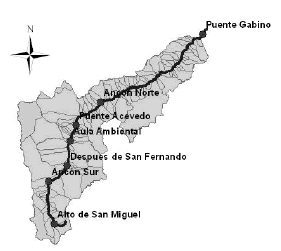
Figure 1. Location of the study reach and the sampling sites
Climate conditions
The predominant climate condition during the sampling monitoring was dry, with low water predominance, the first rain period of the year were over. Daily temperature ranges during the sampling are:
- 6th of June: ranged from 15º C in San Miguel Station at 6 hours and 27º C in Ancón Norte at 16 hours.
- 9th of June: ranged from 17º C in Ancón Sur station at 6 hours, and 30º C in Ancón Norte Station at 16 hours.
- 15th of June: ranged from 17º C in Ancón Sur station at 6 hours and 29.5º C in Ancón Norte station at 16 hours.
- 19th of June: ranged from 18º C in Ancón Sur at 6 hours and 30º C in Ancón Norte at 16 hours.
- 20th of June: ranged from 18º C in Ancón Sur at 6 hours and 32.5º C in Ancón Norte at 13 hours.
Sampling and measured parameters
During a 10 hour period a sample on each station were composed, each hour, with a punctual-integrated take, for the nitrogen determination such as nitrites, nitrates, ammoniac nitrogen and organic nitrogen, determined in the laboratory according to the techniques established on the Standard Methods [10].
4. RESULTS
In figure 2 the experimental results obtained on the low water samples on the Medellin River were shown, on each of the seven stations considered. On those samples we can appreciate a general increasing of the levels on the different nitrogen forms until station number 6: Ancón Norte, place where the river has received over 80% of the residual waters of the Aburrá Valley. On the last station (7: Puente Gabino) on the contrary, a decreasing concentration is observed, which obeys to a dilution process, because in the Ancón Norte-Puente Gabino reach, the river waters have better quality.
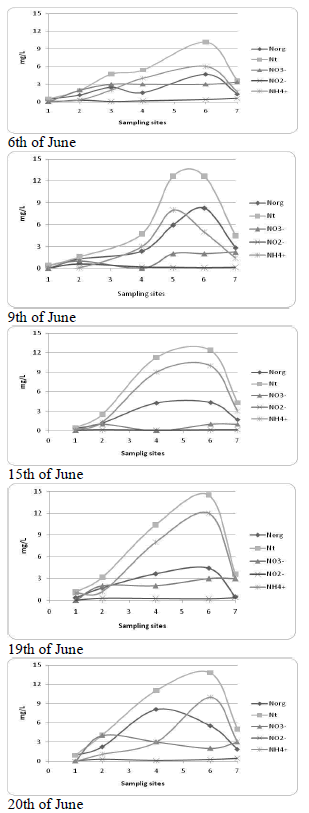
Figure 2. Spatial and temporal variation of nitrogen during low water period in 2007
5. DISCUSSION
When the different nitrogen forms evaluation took place on the monitoring stations (see figure 2), we can appreciate that all of them have an increasing tendency until station 6: Ancón Norte and the nitrite concentration are low for all the samplings on each station (<0.6mg/L), followed by the nitrate concentration, meanwhile, the ammoniac represents the main nitrogen forms on the river.
We must point that, for three samplings, the nitrate concentration decreases on the Aula Ambiental Station (station 4), despite the great availability of oxygen on this station (this oxygen is captured, possibly in a hydraulic jump, located waters up from this station, under the Plaza Minorista bridge).
In figure 3 we can see the behavior of the different nitrogen forms on the river profile.
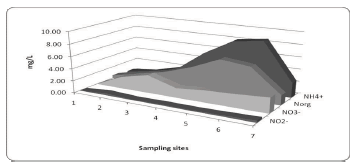
Figure 3. Average of spatial variation of different forms of nitrogen in 2007
After the stretch between station 2: Ancón Sur and station 3: After San Fernando, a nitrate water concentration increase is noticed (1mg/L), even above the organic and the ammonia nitrogen, evidencing a biological action of conversion from organic forms to the ammonia nitrogen, and then until nitrates. The above means that there are place to aerobic nitrification processes and, presumably, organic matter degradation (see figure 3).
Between station 3: After San Fernando and station 6: Ancón Norte, a critic stretch is found, which corresponds to the water quality, for several reasons: the ammonia nitrogen reaches levels up to 8mg/l, the organic nitrogen up to 6mg/l, which indicates a considerable amount of nutrients and organic charge that is presumably degradable. Nonetheless, when looking at the nitrate contents, the composition is low despite the availability of organic nitrogen and ammonia nitrogen that has to be degraded. When looking further down waters, it will be noticed a new increase of the nitrate production until station 7: Puente Gabino. Evidence from this stretch, suggest questions such as: why the stretch between station 3: After San Fernando & 7: Ancón Norte, inhibits nitrification? Could be happening the same with the present organic matter, been inhibit its aerobic degradation? Some elements allow explaining the obtained results:
The oxygen is no favorable in this river stretch for a nitrification process, which is possible because in general, is the most dissolve oxygen-deficit stretch. Nonetheless, on station 4: Aula Ambiental, it presents an increase of the dissolve oxygen levels, product of the turbulence generated by the hydraulic bump up the station. But, not all of this oxygen concentration that is earned is available for metabolic processes, because it begins to quickly drop its concentration en equality with the atmospheric oxygen.
The industrial residual component generates spills capable of inhibit the biological reactions, which weakens the depuration processes that in its majority are made by biological species.
The organic charge in this stretch of the river is such that aerobic degradation processes has not the possibility of being complete on its totality, from the water source until the river enhance its conditions by the dilution. It's known that the biological processes that a reactor system posses a determined food/micro organisms ratio, if this ratio changes, the bacterial degradation process stop from being optimal. For the Medellin River, this dynamic should not be different. In the moment that this substrata or organic material is very low, and the degradation will be scarce, and on the contrary, if the substrata content overcome the limit of mud that a bacteria group can tolerate, the system collapses and degradation stops. [11] The nitrification, and in general, the biological organic degradation, become part of this process.
The reducing bacteria presence like Escherichia coli, Klebsiella sp, Entetobacter sp and some others, that has been found on this stretch of the river in an increased way, could been participating of these transformations, which generates an interference on the nitrification processes.
The presence of benthic algae that are chemical modulators and participate in the different nitrogen forms transformation.
Looking for a better understanding of the behavior and evolution of the nitrogen present in the river, as a water quality index, an additional bibliographic revision was made from the different monitoring on the river, finding nitrogen data for: 1973 [12], 1997 {13], 2001 [14], 2004 [15], 2006 [16] & 2007 [17]. The results are synthesized on figure 4.
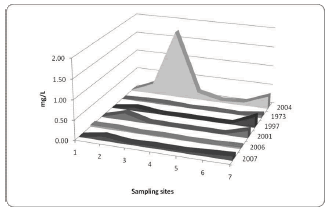
Figure 4. Temporal variation of nitrite in the Medellin River
When the nitrite and nitrate temporal evaluation is evaluated on the river (figure 4) high nitrite concentrations (0.02-1.75 mg/L) are appreciated on the year 2004, which samplings correspond to a low water period, that intense a little bit more the conditions of the river, nonetheless, a high value is highlighted (outside the typical behavior), was presented on the station After San Fernando, which possibly obeys to a residual-treated spill on the residual water plant of San Fernando. On figure 4, also is confirmed, that since 1973 between stations 3: After San Fernando and 6: North Ancon, a critic stretch is found, where the nitrification process decreases, situation that has become more evident over time.
A similar behavior is presented on the nitrate content on the river (see figure 5) where it is evidenced a decrease on the concentration in the stretch, nonetheless, catches the eye that the high nitrate values reported on the second biological evaluation that Mi Rio institute made on 2001 [14].
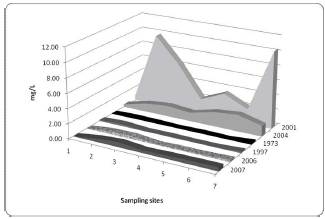
Figure 5. Temporal variation of nitrate in the Medellin River
On figures 4 and 5, it can be appreciated that apparently a positive impact were not noticed, with the start of the treatment plant San Fernando on December 1999. Nonetheless, on 2006, can be appreciated a decrease on the nitrite and nitrate contents, which possibly obeys to a dilution process generated by the climate conditions.
Looking to relate the nitrogen concentrations with the conurbation process of the Aburrá Valley, a revision was made on how this process has been performed. In the study "La ocupacióndel territorio en el proceso de urbanización del Área metropolitana del Valle de Aburrá"; [18], four historical moments are taken in consideration: 1948, 1970, 1985 & 1996 as determinants to understand the process of urban occupation of the territory in the Aburrá Valley. With cartography support the urban growth is evaluated in these four moments, which allow defining the way the territory was occupied: Poly-nuclear, with a dominant core and concentrated growth, contained on its geographical delimitation.
On the first decades of the 20th Century, Medellin, suffers great transformations. These changes are expressed in the population increase and the physical expansion of the city, the surge of "urban"; behaviors, but first of all the apparition of a new economical activity: the industry that transforms the landscape, the work relationships, the capitals, and the day-by-day city life [18].
This industrialization attracts a great amount of migrant population to the center of the region, which obtained work on the ground-settled factories when a major development was foreseen.
All this population growth and the industrial settlements (see figure 6) increases the life quality, becoming into an attractive for the establishment of new people and some other activities, that brought along a new demand of resources specially water supplies, with the consequent generation of solid and liquid residues, that, for some time, were indirectly spilled into the water bodies. On the Medellin River, the spills accentuate on the more dense growth cores, such as Medellin city.
Those spills, more and more continuous on the Medellin River, that work as a receptor not only from residual waters of the slope settlements, as well as the great amount of contaminated waters that started to flow to the rivers by affluent streams, deny it the chance to recover in a natural way, started to overcome its natural auto depuration capacity, generating a misbalance, that takes to change the uses of this water body and even the community approach and vision of the river: it passes from a spreading area, on the decade of the twentieth, with a beautiful surrounds that incite the people from Medellin to enjoy the river for fun, to think it, today, as a canal that carries bad smell waters. And even though we don't have any record about the water quality on the first decades of the 20th Century, it is possible to put in evidence how the region growth in terms of population and industrialization, generated an impact in the nitrite and nitrate contents on the Medellin River. Is that the reason that, when a correlation is made with the occupancy process of the growth in the Aburrá Valley (figure 6) with the nitrogen concentrations (figures 4 and 5), can be found that despite the population growth, the river conditions are more and more critical, because it has to be the recipient of a larger residual water content.
Conscious of the great impacts that were taking place on the superficial streams, Empresas Públicas de Medellin (EPM), took actions like: the construction of the first collectors and interceptors during the 60's and 70's, the factibility study of the Medellin River healing study (PSRM) between 1981 & 1983, the design and construction of the San Fernando Plant in the second half of the 90's, aside with a permanent recollection program of residual waters. Because of this, some stretch of the river the physical-chemical conditions improve, which for nitrogen it can be seen on the ammoniac and organic nitrogen levels on the south stretch to station 4: Aula Ambiental. After this site a high compound levels are placed, as a result of the discharge of the interceptors on the Moravia zone (figure 2). The EPM healing plan has minimized the entry of residual waters in the canalized stretch until the entrance of the interceptor waters, which without a doubt has put some relief to the river.
6. CONCLUSIONS
The Medellin River, recognized as the articulator axe of the Aburrá Valley, has been affected in the occupation process of the territory as a consequence of the spills of domestic and industrial residual waters, which reach a volume that overcome the capacity that the river posses for its assimilation in a natural way, generating a misbalance in the ecosystem.
Product of this misbalance, we have a river stretch on critical conditions because of the ammonia and organic nitrogen concentration, which indicates a considerable charge of nutrients, nonetheless, when we evaluate in the same stretch the nitrate contents, the composition is very low even with the availability of organic and ammoniac nitrogen that made the degradation process. For a better understanding of this phenomenon it requires to study in depth a study in which the bacteria populations associated to nitrification like: Nitrosomonas, Nitrosococcus, Nitrosolobus, Nitrosovibrio, Nitrosospira and Nitrobacter can be associated.
Empresas Públicas de Medellin has made a series of actions contemplated in the Healing Plan that has improved the conditions of the river in some stretches. That has been possible thanks to the construction of collectors and interceptors that take the waters and avoid straight spills into the water bodies.
ACKNOWLEDGMENTS
We express our gratitude to the Antioquia University, to the GIGA Group, and the Metropolitan Area of the Aburrá Valley, and the engineer Osfredilian Gallo for his efforts and contributions to this experimental work.
REFERENCES
[1] FUENTES, F. And MASSOL-DEYÁ, A. Manual de Laboratorios: Ecología de Microorganismos. Universidad de Puerto Rico. Derechos Reservados1996. Revisado 2002. [ Links ]
[2] ROMERO, J. A. Acuiquímica. Escuela Colombiana de Ingeniería. Bogotá. 1996. [ Links ]
[3] MCCARTHY, PERRY L. PARKIN, GENE F. SAWYER, CLAIR N. Química para ingeniería ambiental. Cuarta edición. Bogotá 2001. [ Links ]
[4] JENKIS, D. Y SNDEYINK, V. Química del agua. Séptima reimpresión. México, 2000. [ Links ]
[5] RAMÍREZ, A, VIÑA VIZCAÍNO G. Limnología Colombiana. 1998. [ Links ]
[6] CHAPRA, S.C. Surface Water-Quality Modeling. 1997. [ Links ]
[7] ATLAS, R.M, BARTHA R. Ecología microbiana y microbiologia ambiental. Pearson Cuarta edición. 2006. [ Links ]
[8] MARIN, C. J. DE MEDINA, H. Bacterias asociadas a la transformación de nitrógeno en la interfaz agua sedimentos del cono hipolimnético del lago de Maracaibo, Venezuela. Revista Electrónica Scielo. Universidad de Zulia. 2006. URL disponible en www.serbi.luz.edu.ve/pdf/bcib/v40n1/art_02.pdf Consultada: 23/02/09. [ Links ]
[9] ECHARRI LUIS. Ciencias de la Tierra y del Medio Ambiente. España, 1998. [ Links ]
[10] AMERICAN PUBLIC HEALTH ASSOCIATION, AMERICAN WATER WORKS ASSOCIATION, WATER POLLUTION CONTROL FEDERATION. Standard Methods for the Examination of Water and Wastewater. 21 ed, New York, 2005. [ Links ]
[11] CAMARGO, J., ALONSO A. Ecological and toxicological effects of inorganic nitrogen pollution in aquatic ecosystems: A global assessment. Environment International 32, 831-849, 2006. [ Links ]
[12] EMPRESAS PÚBLICAS DE MEDELLÍN. Estado de la contaminación del Río Medellín. Medellín, 1973. [ Links ]
[13] INSTITUTO MI RÍO. Aspecto biológico y fisicoquímico del río Medellín. Medellín, 1997. [ Links ]
[14] INSTITUTO MI RÍO. Segunda evaluación biológica del río Medellín. Medellín, 2001. [ Links ]
[15] ÁREA METROPOLITANA DEL VALLE DE ABURRÁ. Diseño y Puesta en Marcha de la Red de Monitoreo Ambiental en la Cuenca Hidrográfica del Río Medellín en Jurisdicción del Área Metropolitana. Fase 1. Medellín, 2004. [ Links ]
[16] ÁREA METROPOLITANA DEL VALLE DE ABURRÁ Diseño y Puesta en Marcha de la Segunda Etapa de la Red de Monitoreo Ambiental en la Cuenca Hidrográfica del Río Aburrá en Jurisdicción de Área Metropolitana. Medellín, 2006. [ Links ]
[17] GIRALDO, L. C. Análisis del potencial de autorecuperación del río Medellín en el tramo k21-k44, mediante el estudio de la situación actual y la incorporación de biotopos-sustratos artificiales. Universidad de Antioquia (trabajo en ejecución). Facultad de Ingeniería. Antioquia. [ Links ]
[18] SCHNITTER, P., GIRALDO, M. L. AND, PATIÑO J. M. La Ocupación del Territorio en el Proceso de Urbanización del Área Metropolitana del Valle de Aburrá, Colombia. Revista Electrónica de Geografía y Ciencias Sociales. Universidad Barcelona Vol. X, núm. 218 (83), 1 de agosto de 2006. URL disponible en http://www.ub.es/geocrit/sn/sn-218-83.htm Consultada: 23/02/09. [ Links ]














